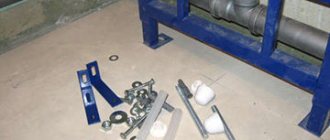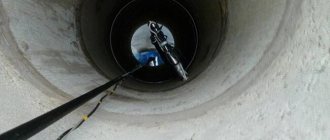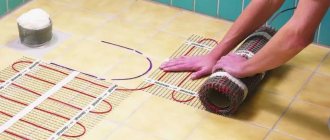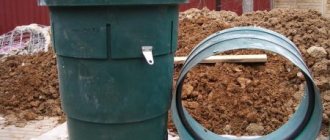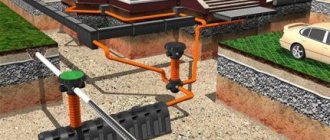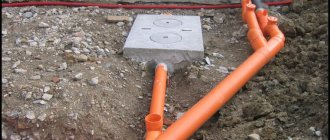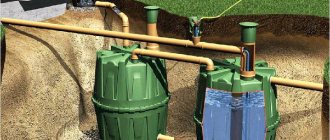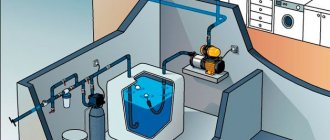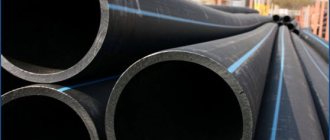Having decided to purchase a country house, you first need to find out whether electricity is supplied to it and whether there is water in the garden area. And if the first problem can be solved today, then the second may become an obstacle to the purchase of this particular plot. After all, without water it is just a piece of land, and talking about people living on it makes no sense. The way out of this situation is to extract water by digging a well. And plastic pipes will help to equip it.
Corrugated pipes of large diameters can be used to equip a drinking well shaft
Advantages and disadvantages
Wells made of polymer pipes have a number of advantages: as a result, this type of structure began to gradually replace traditional structures made of reinforced concrete rings.
The following strengths of plastic wells can be identified:
- These structures have no seams, which ensures absolute tightness of the structures. As for reinforced concrete wells, the connecting seams between the individual rings lose their reliability over time.
- The price of the material is quite low.
- Plastic pipes are light in weight, which makes installation work on wells much easier.
- The design is not afraid of rotting and corrosion. As a result, harmful impurities do not get into drinking water.
- Plastic conducts heat very poorly, which significantly minimizes the threat of water freezing in the well in winter.
- Due to the fact that the plastic pipe for the well is equipped with stiffening ribs, this makes it much stronger.
- Plastic walls do not contribute to the proliferation of harmful microorganisms on their surface.
- The shapes and sizes of polymer pipes are very different, which makes it easier to select the most optimal option for organizing water supply in the country.
- Installation and maintenance of these products is characterized by simplicity, with a significant service life.
As for the disadvantages, they are too frivolous to overshadow the advantages: they can rather be perceived as features that should be taken into account during the operation of plastic structures. For example, to prevent precipitation and mechanical impurities from getting into such a well, you need to use a plastic lid to close its neck. In addition, these structures require periodic maintenance by cleaning the bottom and filters, and carrying out pump maintenance.
Use of one-piece structures
The use of solid structures can significantly speed up the work on storm sewer construction. These include the KND drainage well , which is completely ready for use. A special feature of these products is their exceptional tightness. It is different from any cast product. Solid wells are manufactured with different heights and diameters. Therefore, choosing the necessary product will not be difficult.
Sewage pump for pumping out sewerage. - there is more useful information here.
A cover is supplied with the one-piece drainage well. This product has reinforced walls, supplemented with special stiffening ribs. All this allows the structure to withstand heavy loads that occur in the ground during the changing seasons and winter heaving.
The assembly of composite plastic structures takes much more time than the installation of a finished well.
This is an advantage of solid products, which is used by owners of country houses. The only obstacle may be cost. But all other benefits outweigh this minus.
You will be interested in this article - Bacteria for septic tanks and cesspools.
How to build a plastic well
Drinking water sources are most affected by surface water contamination, which has prompted the development of effective protection methods. One of them is to equip the well with a plastic pipe instead of traditional concrete rings.
It is very important to use seamless products for these purposes, which will guarantee against leakage of water into the shaft. To prevent the source from being covered with sand, geotextiles are used. An important condition is to hit the closest aquifer as accurately as possible. Strictly speaking, a well made of a plastic pipe acts as a capture well, accumulating groundwater.
Construction activities for the construction of a plastic well are carried out in the following sequence:
- Purchase two-layer pipes for a drinking water well with a diameter of 400 mm: they are specially designed for underground use.
- Determine the point in the garden area with the maximum pressure of an underground source, which is within the power of a hydrogeology specialist. For independent searches, they usually use one of the old-fashioned techniques, the most common of which is the vine method.
- Dig a well shaft using the open method. After passing a 2-meter depth, the hole must be given a round shape throughout the rest of the section.
- As soon as signs of a key appear, a plastic seamless pipe should be prepared. It must be lowered into the shaft carefully, making sure that the product reaches the very bottom.
- After installing the pipe, the space between its outer walls and the surface of the shaft is filled with sand.
When preparing the pipe, the following steps must be taken:
- The cavities of the fins in an area of 500 mm are equipped with a series of holes, for which a 7 mm drill is used.
- The openings of the hole and the pipe are wrapped in two layers of geotextile.
- To secure the well filter, a wire placed in a plastic sheath is used. With its help, the interior of the well will be protected from sand, and water will flow unhindered.
- Typically, about 1 meter of plastic pipe protrudes above the ground surface: polystyrene foam can be used to insulate this section.
- The well is pumped using a submersible pump. To ensure high quality water, it is practiced to fill the pipe lumen with shungite or quartz sand.
Size selection
The category of large pipes includes models with a diameter of over 500 mm. The choice is made according to the appropriate hardness class:
- SN2 (suitable for laying a pipeline under the ground at a depth of 2 meters). Available options O 60, 90, 150 cm;
- SN4 (laying to a depth of 2-4 m is allowed), Ø 68, 97, 160 cm;
- SN6 (maximum depth 4-6 m), Ø 70, 100, 180 cm;
- SN8 (depth 6-8 m), Ø 70, 100, 180 cm;
- SN12 (possibility of laying at 8-12 m), options Ø 80, 120, 220 cm;
- SN14 (maximum depth 12-16 m), Ø 85, 130, 240 cm.
How to build an Abyssinian well
An Abyssinian well or Abyssinian well is a thin channel in the soil, for the construction of which the ground is pierced to a depth of 10 m. This channel is then formed using a pipe for a drinking well with a diameter of up to 1.5 inches. The well bottom is covered with marble chips. Due to its weak strength properties, a plastic pipe cannot be used to pierce the soil, so it is assigned exclusively a transporting function. Holes in the ground can be made with a garden auger, using collapsible rods to reach the aquifer.
The pipe is cut into pieces 1-2 m long: with their help, a hole in the ground is constructed using the extension method. It is very important that the pipe connections are as reliable as possible to avoid damage to the structure. In order for the pipe to move along the channel without delay, a filter needle is placed on its tip (it will also help clean the incoming water from all kinds of debris, and thus the source will not be flooded). When water appears in the well, deepening work stops and the flushing process begins. As a rule, self-purification of water occurs within 24 hours, after which it can be safely used for household and food purposes.
Abyssinian wells have the following advantages:
- Good service life.
- Ability to supply excellent quality water. The self-priming pump and the small cross-section of the well make it much more difficult for various impurities, debris and bacteria to penetrate into the well.
- Small capital investments during arrangement.
Year-round operation
The main problem with water supply to the house is freezing of pipes and pumps. These problems can be solved by proper pipe laying and placement of equipment in the house (read about installing a tap for a drinking water filter here) or a caisson.
A successful option would be to create a well in the basement of the house.
A caisson is a excavation in the soil below the freezing depth or a metal or brick structure lowered to the same depth.
The caisson chamber is additionally finished with waterproof and heat-insulating materials.
Restoration of wells and reinforced concrete
With the help of polymer materials, not only the creation of new wells is carried out, but also the resuscitation of old ones. If there is a well on your personal property, the water in which has lost its former quality, the easiest way is to install plastic pipes inside the old shaft from reinforced concrete rings.
The plastic structure should be 10-20% smaller in diameter than the old rings. Cement mortar is usually used to fill the niche between two channels. Repairing a well with a plastic pipe allows you to create a reliable barrier to various contaminants: their occurrence is explained by disturbances in the structure of the concrete rings, as well as the accumulation of plaque on their surface.
Types of plastic sewer wells
With the help of polymer pipes, systems for removing waste products are often installed. As the SNiP requirements state, each sewerage system must have special inspection wells: regulatory documents are used to determine their number. Such wells are designed to maintain the functionality of the system and its timely maintenance.
The following types of sewer wells are distinguished:
- Rotary . It is mounted in areas where the transported liquid turns in one direction.
- Overflow . Allows you to monitor the operation and maintenance of drainage when moving from one diameter to another.
- Lookout . With its help, straight sewer lines over 12 m long are serviced.
When using any of the above wells, it is important to keep in mind the likelihood of the structure floating up if it is buried lower than the ground aquifer. To prevent this unpleasant phenomenon, a special concrete anchor is used. In addition, the bulk layer of earth must be thoroughly compacted.
What kind of plastic pipes are used to equip wells and boreholes?
The following materials can be used to produce pipes of this type:
- Low-pressure polyethylene.
- Polypropylene.
- Polyvinyl chloride.
- Unplasticized polyvinyl chloride (UPVC).
Plastic pipes for wells and manholes are available in the following varieties:
- Triangular profile with short or long thread. In the first case, the wall thickness is 6 ≤ Sst. ≤ 15 mm, diameter 114 ≤ D ≤ 508 mm. To connect such pipes, suitable couplings are used. Cone-shaped threads are mainly used. As for products with long threads, they have the following parameters: wall thickness 6 ≤ Sst. ≤ 15 mm, with a diameter of 114 ≤ D ≤ 245 mm. In this case, special devices are used for cutting or rolling threads, but the end is always given the shape of a cone.
- A trapezoidal profile equipped with a cone-shaped thread. These plastic pipes are characterized by the following parameters: diameter 114 ≤ D ≤ 245 mm, with a diameter of 114 ≤ D ≤ 245 mm.
- Pipes with particularly tight connections. With the help of these products, highways are assembled on soils of high humidity.
The importance of following safety precautions
If drilling a well with your own hands is an impossible task, then building a well relying solely on your own strength is quite possible.
When working with soil, it is important not to forget about safety precautions; be sure to use gloves, helmets and special clothing. Use pulley systems to lift large stones. You will definitely need tools for cutting the roots of trees and shrubs. Be careful and attentive when working with tools. Most injuries while doing DIY work are caused by negligence.
Comparative characteristics of plastic products
If you decide to use plastic pipes in the construction of a well or borehole, you should take into account the specific properties of different polymers.
Namely:
- HDPE pipes have a density of 0.94/0.96, and PVC-U pipes have a density of 1.4 g/cm3.
- HDPE pipes have an allowable design stress of 50/63 MPa. PVC-U pipes have 2 times the same indicator 100/125 MPa.
- Elastic modulus. For HDPE it is 900. For uPVC it is 3000.
- As for the tensile yield strength of the material, for HDPE it is 20/30 MPa, for uPVC - 50/56.
List of technological advantages of PVC-U pipes:
- Due to their higher yield strength, it is more convenient to use threaded connections on these pipes. A large diameter plastic pipe for a well of this type at a depth of 30 m will have a sevenfold safety margin. At the same time, loads of up to 5 tons can be applied to the product.
- PVC-U products are characterized by higher hydraulic performance: these parameters are almost the same as those of metal pipes.
Using HDPE pipes, it is recommended to equip wells no deeper than three meters. It is better to equip wells with uPVC products. When purchasing a suitable pipe, it is important to pay attention not only to its parameters, but also to what kind of plastic it is made of (fortunately, such information is available in the accompanying documentation). Sometimes it happens that they try to sell HDPE pipes under the guise of uPVC products.
